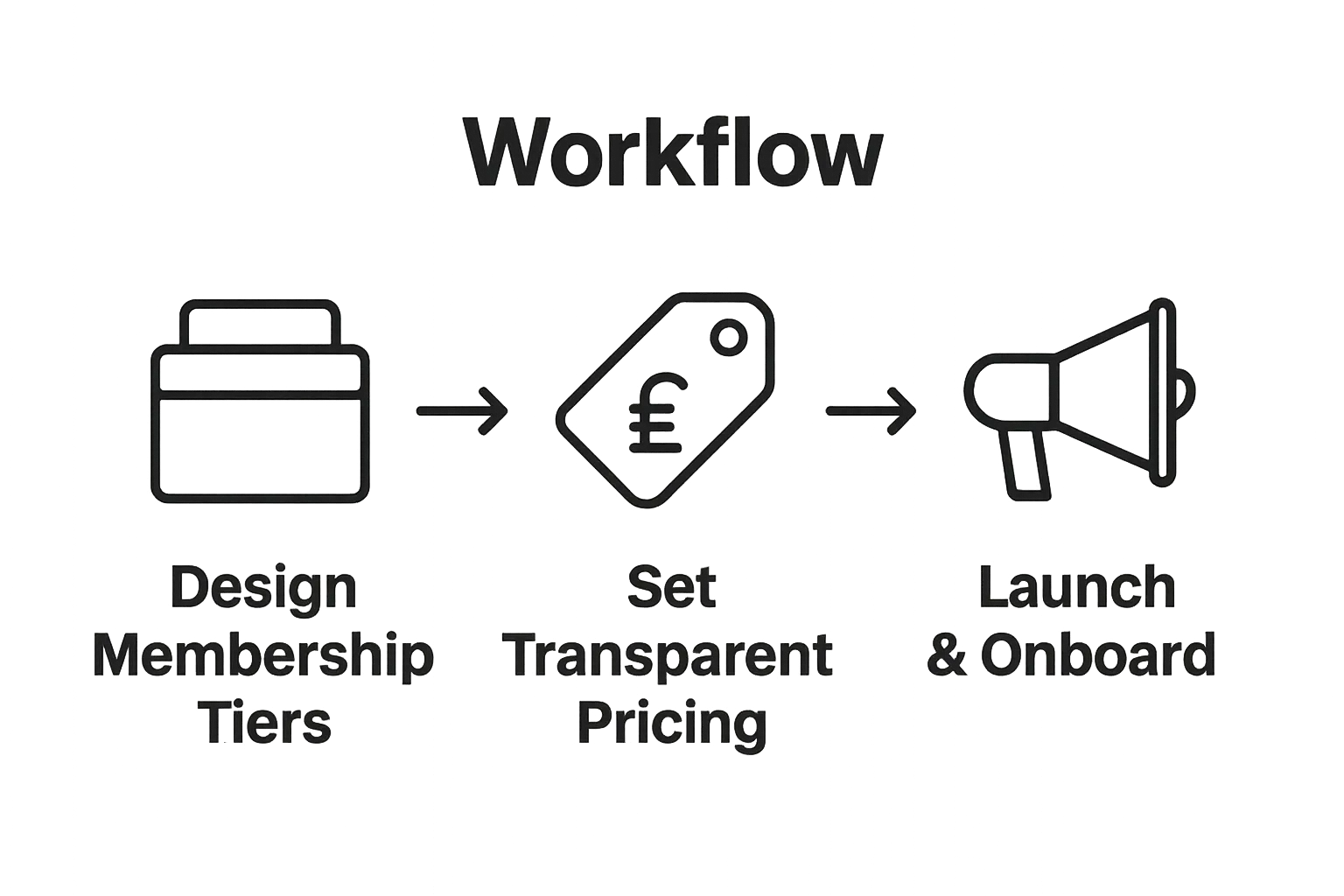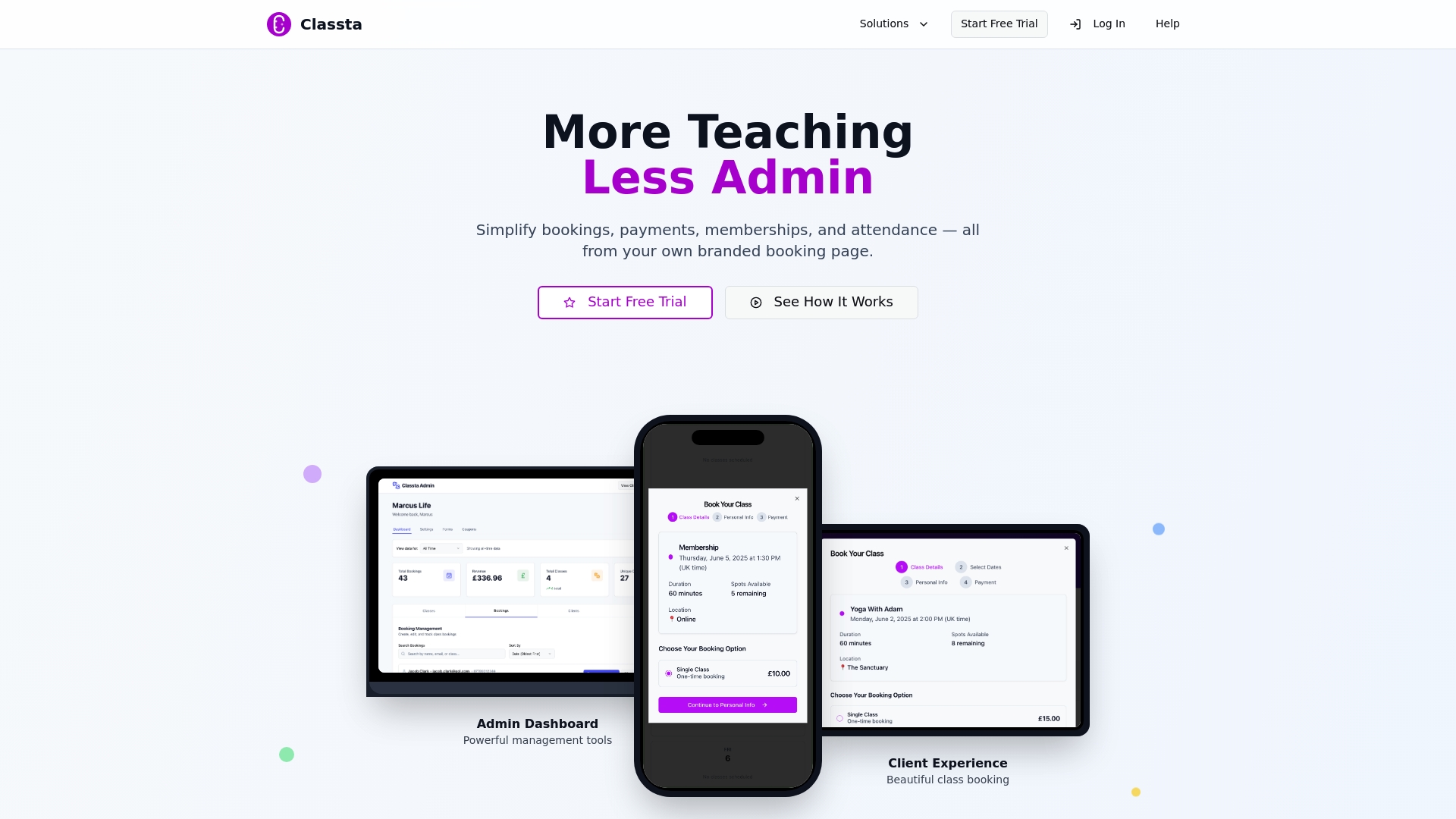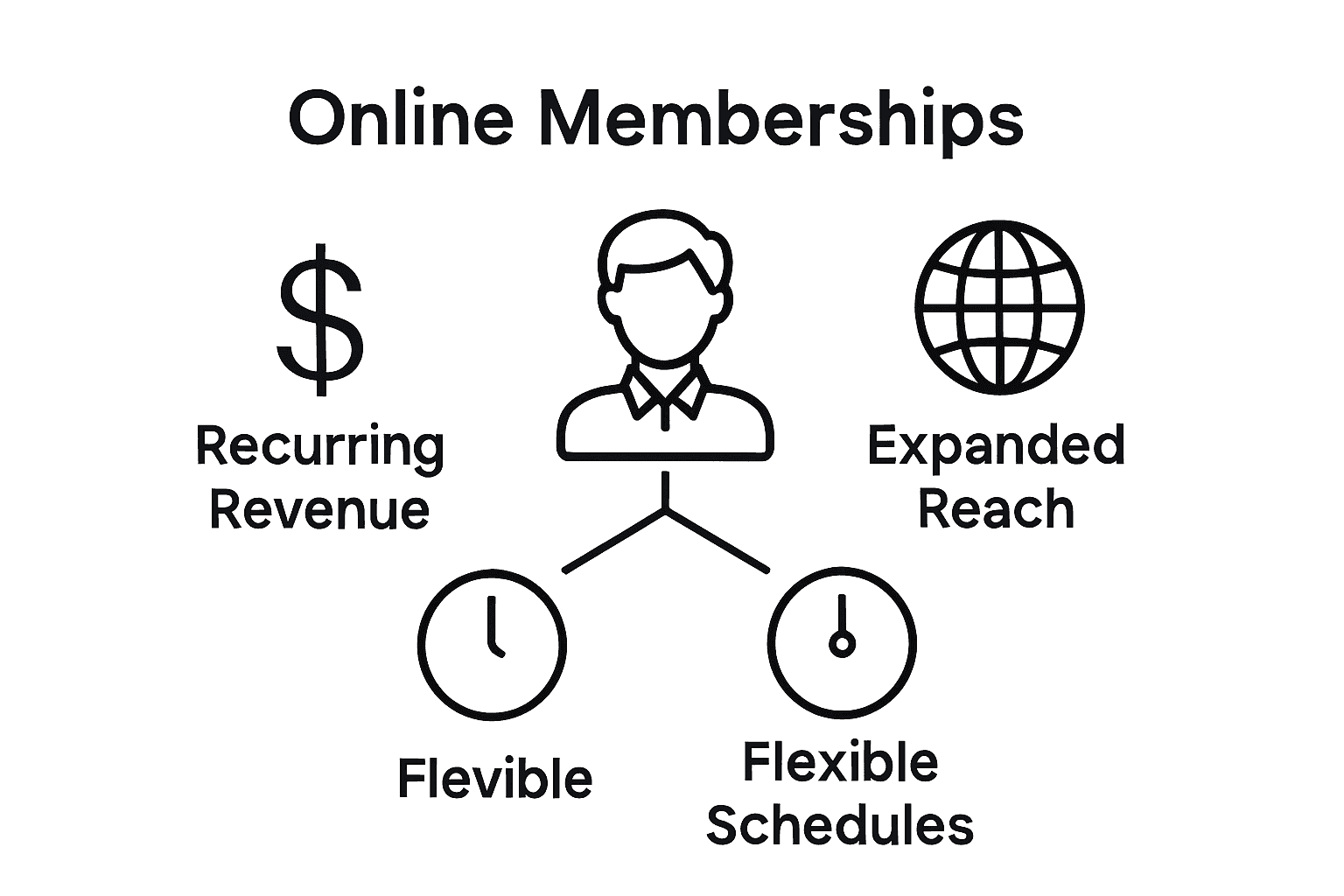Setting up a pilates membership model can completely transform your studio’s stability and client engagement. Most instructors focus on creating attractive class timetables or hiring top trainers. Yet tiered membership structures can actually boost predictable income and drive up retention rates by as much as 30 percent when done right. The surprising part is it’s not just about the classes you offer, but how clearly you communicate value, flexibility, and personalised options from day one.
Table of Contents
Quick Summary
| Key Point |
Explanation |
| 1. Develop tiered membership levels |
Create various membership options to cater to different client needs and budgets, improving accessibility and revenue predictability. |
| 2. Set clear and competitive pricing |
Transparent pricing enhances client trust and offers tailored payment plans, helping to convert potential clients into committed members. |
| 3. Choose an effective management platform |
A good membership platform simplifies client management, payment processing, and data analysis, streamlining overall business operations. |
| 4. Monitor and adjust offerings regularly |
Regular assessments of membership performance ensure that your offerings stay relevant and valuable to clients, promoting retention. |
| 5. Communicate benefits clearly in marketing |
Use compelling marketing strategies to inform potential members about advantages, enhancing interest and initial sign-ups. |
Step 1: Assess Your Membership Model Options
Designing an effective pilates membership setup requires careful consideration of different membership models that align with your business goals and client needs. This foundational step determines how you will structure your pricing, attract clients, and create sustainable revenue streams for your pilates practice.
Understanding Membership Structures
When exploring membership options, you’ll encounter several strategic approaches. Tiered membership models offer clients flexibility while providing your business with predictable income. Consider developing membership levels that cater to different client commitments and financial capabilities. For instance, you might create entry level memberships with limited class access, mid tier memberships with more comprehensive benefits, and premium memberships with additional personalised services.
According to Entrepreneur Magazine, successful membership structures typically include clear value propositions for each tier. Your pricing should reflect not just class access, but the overall experience and additional benefits clients receive. This might include perks like online class recordings, one-on-one consultations, nutrition guidance, or exclusive workshop access.
Strategic Pricing Considerations
Pricing becomes critical in your pilates membership setup. Research suggests clients appreciate transparent, straightforward pricing models that provide clear value. Monthly recurring memberships often work best, allowing clients predictable budgeting while giving your business consistent revenue. When determining pricing, factor in your operational costs, instructor wages, studio expenses, and desired profit margin.
Calculate your pricing by considering both market rates and the unique value of your pilates offerings. Some instructors implement introductory rates to encourage initial sign ups, then transition clients to standard membership pricing. Others offer annual memberships with slight discounts to incentivise longer term commitments.
As you design your membership model, remain flexible. The most successful pilates businesses continually evaluate and adjust their membership structures based on client feedback and business performance metrics. Your goal is creating a membership setup that feels valuable to clients while supporting your business growth and sustainability.
Below is a comparison table outlining common pilates membership tier options, their typical benefits, and client suitability to help you decide which structures best fit your studio’s needs.
| Membership Tier |
Example Benefits |
Best Suited For |
| Entry Level/Basic |
Limited weekly class access, access to online recordings |
Beginners, budget-conscious clients |
| Mid Tier/Standard |
Increased weekly classes, some consults, nutrition guidance |
Regular attendees, progressing clients |
| Premium/Comprehensive |
Unlimited classes, 1:1 consultations, exclusive workshops, extra perks |
Highly committed, wellness-focused clients |
| Annual Plan |
All above benefits with yearly discount, priority booking |
Long-term clients seeking savings |
| Flexible Package |
Pay-per-class or short course bundles, minimal long-term commitment |
Casual attendees, trial users |
Selecting the right membership management platform represents a critical decision in your pilates membership setup that can significantly impact your business efficiency and client experience. This step transforms how you track, manage, and engage with your clients, turning administrative tasks from complex challenges into streamlined processes.
When evaluating membership management platforms, focus on comprehensive features that simplify your operational workflow. Payment processing should be seamless, supporting multiple payment methods and enabling automatic recurring billing. Look for platforms offering secure transaction capabilities that integrate with popular payment gateways like Stripe and PayPal, ensuring smooth financial transactions without manual intervention.
According to American Council on Exercise, the ideal platform should provide robust reporting tools that give you insights into membership trends, attendance patterns, and revenue streams. These analytics help you make data driven decisions about your pilates business strategy.
Integration and User Experience
Beyond basic functionality, consider how the platform integrates with your existing tools and presents a user friendly experience for both you and your clients. Client management features like automated appointment reminders, class booking capabilities, and personalized communication tools can dramatically reduce your administrative workload. The platform should offer mobile responsiveness, allowing clients to manage their memberships, book classes, and update information from their smartphones.
Your chosen platform must provide scalability, accommodating your business as it grows. This means easy addition of new membership tiers, flexible class scheduling, and the ability to customize your offerings without requiring complex technical skills. Some platforms offer built in marketing tools, helping you promote special classes, manage email communications, and track client engagement.
This table summarises essential features to consider when choosing a pilates membership management platform, highlighting their functions and the value they add for both studio owners and clients.
| Feature |
Purpose/Function |
Value to Business and Clients |
| Secure Payment Processing |
Handles payments, supports multiple methods, recurring billing |
Reduces admin, increases reliability |
| Automated Reminders/Bookings |
Sends appointment/class reminders and manages bookings |
Cuts no-shows, improves experience |
| Reporting & Analytics Tools |
Tracks attendance, revenue, conversion rates |
Enables data-driven decisions |
| Mobile Responsiveness |
Allows clients to manage memberships via smartphones |
Convenience, modern client expectations |
| Marketing & Communication Tools |
Manages promotions, email campaigns |
Enhances engagement and retention |
| Scalability & Customisation |
Supports tier expansion, flexible class scheduling |
Grows with your business, adapts to changing needs |
Carefully test potential platforms through free trials, focusing on intuitive design, comprehensive features, and alignment with your specific pilates business model. The right membership management platform becomes more than just software it becomes a strategic partner in your business growth.
Configuring membership tiers and pricing is a strategic process that directly impacts your pilates business revenue and client attraction. This step requires careful balance between creating value for clients and establishing sustainable financial models for your practice.
Designing Strategic Membership Levels
Develop membership tiers that reflect different client commitment levels and engagement needs. Basic membership might include limited weekly classes, while premium memberships could offer unlimited access, personalised consultations, and additional wellness resources. Consider creating three primary tiers: starter, standard, and comprehensive. Each tier should provide clear, escalating benefits that motivate clients to upgrade their membership.
According to Fitness Business Management Research, successful fitness businesses design membership structures that feel like progressive value propositions. Your pricing strategy should communicate the incremental benefits clients receive at each membership level, making upgrades feel like natural, attractive choices.
Pricing Psychology and Flexibility
Pricing goes beyond simple cost calculation it involves understanding client perception and value interpretation. Psychological pricing techniques can make your membership levels more appealing. For instance, positioning your standard membership as the most attractive option by carefully structuring its price point and benefits can encourage more clients to select this tier.
Consider offering flexible payment options such as monthly recurring payments, quarterly plans with slight discounts, and annual memberships with more significant savings. This approach provides clients multiple entry points and demonstrates your commitment to accommodating different financial capabilities. Some pilates studios also implement introductory rates or trial periods to reduce initial commitment barriers.
Regularly review and adjust your membership tiers based on client feedback, attendance patterns, and business performance metrics. The most successful pilates membership setups remain dynamic, evolving to meet changing client needs while maintaining a clear, value driven pricing structure.

Step 4: Set Up Payment Processing Systems
Establishing robust payment processing systems represents a crucial component of your pilates membership setup, ensuring smooth financial transactions and maintaining professional credibility. This step transforms how you collect payments, manage recurring billing, and provide clients with seamless payment experiences.
Selecting Secure Payment Gateways
Choosing the right payment gateway involves more than simply accepting credit cards. Look for platforms that offer multiple payment methods, including credit cards, digital wallets, and direct bank transfers. Security becomes paramount when handling client financial information. Prioritize payment processors with PCI DSS compliance, which guarantees robust protection against potential data breaches.
According to Payment Systems Research, fitness businesses benefit from payment systems that support automatic recurring billing. This feature allows seamless monthly membership charges, reducing administrative work and minimising payment interruptions. Integrated systems that automatically send payment reminders and handle failed transactions can significantly streamline your financial management.
Integration and Client Experience
Your payment processing system should integrate smoothly with your membership management platform. Clients appreciate intuitive interfaces that allow easy online payments, subscription management, and transparent billing histories. Consider platforms offering mobile responsive payment interfaces, enabling clients to update payment methods, view invoices, and manage their memberships directly from smartphones.
Implement clear communication protocols around payments. Provide transparent pricing, send advance notification for upcoming charges, and offer straightforward cancellation processes. This approach builds trust and reduces potential client friction. Some pilates businesses offer flexible payment options like monthly, quarterly, and annual plans, each with slight pricing incentives to encourage longer term commitments.
Carefully test your chosen payment system through trial periods, ensuring all features work correctly. Verify that automatic recurring billing functions smoothly, payment notifications are sent accurately, and client financial data remains completely secure throughout all transactions.
Step 5: Launch Your Membership Program
Launching your pilates membership program marks a pivotal moment in transforming your practice from a simple class offering to a comprehensive client experience. This step requires strategic planning, clear communication, and a thoughtful approach to introducing your new membership structure to existing and potential clients.
Marketing and Communication Strategy
Develop a comprehensive communication plan that introduces your membership tiers with clarity and excitement. Create compelling marketing materials that highlight the unique benefits of each membership level, focusing on the value clients receive beyond just class access. Utilize multiple channels such as social media, email newsletters, and your studio’s website to spread the word about your new membership offerings.
According to Fitness Marketing Insights, successful program launches involve creating a sense of exclusivity and limited time opportunity. Consider implementing a special introductory offer that encourages early sign ups, such as discounted rates for the first three months or additional complimentary services for initial members.
Implementation and Client Onboarding
Your launch should include a smooth onboarding process that makes joining your membership program feel effortless and exciting. Prepare comprehensive information packets that clearly explain membership benefits, class schedules, and how to access various membership features. Develop a welcome strategy that includes personal touches like a welcome email, introductory consultation, or a small welcome gift that makes new members feel valued.
Host a launch event or series of special classes that showcase the unique aspects of your membership program. This approach not only generates excitement but also provides potential members a low risk way to experience your offering. Consider offering free trial classes or limited time preview experiences that allow clients to test different membership tiers before committing.
Remain flexible and responsive during the initial launch phase. Collect feedback from early members, be prepared to make quick adjustments, and demonstrate your commitment to creating a membership experience that truly meets client needs. Your launch is not just about selling memberships, but about building a community of dedicated pilates practitioners who feel genuinely supported in their wellness journey.
Step 6: Monitor, Evaluate and Adapt Your Membership Offerings
Monitoring, evaluating, and adapting your membership offerings represents the ongoing process that transforms a static membership program into a dynamic, client focused system. This critical step ensures your pilates business remains responsive to client needs, market trends, and your own strategic goals.
Implement comprehensive tracking mechanisms to gather meaningful insights about your membership performance. Utilize your management platform’s analytics tools to monitor key metrics such as membership retention rates, class attendance, revenue per member, and tier conversion patterns. These data points provide a clear picture of how clients interact with your membership offerings and where potential improvements can be made.
According to Fitness Business Management Research, successful fitness businesses treat member feedback as a strategic asset. Create multiple channels for collecting client perspectives, including digital surveys, informal conversations, and periodic review sessions. Pay special attention to reasons why members might upgrade, downgrade, or cancel their memberships.
Strategic Adaptation and Refinement
Transform your collected data and feedback into actionable strategy. Regularly schedule quarterly reviews of your membership structure, examining which tiers perform best and identifying potential gaps in your current offerings. This might involve introducing new membership benefits, adjusting pricing structures, or creating more flexible class packages that align with evolving client preferences.
Remember that adaptation is an ongoing process. Some pilates studios implement a continuous improvement model, making small, incremental changes based on consistent feedback rather than waiting for major overhauls. Be prepared to experiment with promotional periods, introduce seasonal membership variations, or develop specialised add on services that provide additional value to your clients.
Your goal is creating a membership system that feels responsive and client centric. By maintaining a commitment to ongoing evaluation and strategic refinement, you position your pilates business as a dynamic, client focused practice that continuously seeks to enhance the member experience.

Ready to Streamline Your Pilates Membership Success?
You have just read how challenging it can be to manage membership tiers, automate recurring payments, and deliver a seamless client experience when setting up your pilates membership programme. The emotional strain of manual admin is real, especially when you want to focus on your clients instead of chasing payments or handling class schedules. If you are aiming for a setup that saves you time, cuts out complexity, and enhances your ability to grow sustainable recurring revenue, you need a platform that aligns with each step in your journey – from pricing strategy and branded booking pages to secure payments and seamless automation.

Bring your plans to life now with Classta.co. Enjoy an easy-to-use interface designed for pilates instructors, with all-in-one tools that handle everything highlighted in your guide. Set up custom membership tiers, automate reminders, and receive payments securely so you can focus on your students and your business. Take the next step today and see why so many class-based instructors trust Classta.co to power their growth. Visit Classta.co and reimagine your pilates membership programme without the stress.
Frequently Asked Questions
What are the different membership models for a pilates studio?
Different membership models can include tiered memberships, where clients choose from levels like basic, standard, and premium, each offering varying benefits such as class access, personalised services, and additional wellness resources.
How should I price my pilates memberships?
Pricing should reflect both the operational costs and the unique value of your pilates offerings. Consider implementing monthly recurring memberships, introductory rates, or annual plans to attract clients while providing transparent and straightforward pricing.
Key features to consider include secure payment processing, automated billing, comprehensive reporting tools, client management capabilities, and integration with current tools to streamline administrative tasks and enhance user experience.
How can I effectively launch my pilates membership program?
To launch effectively, create a comprehensive communication plan highlighting membership benefits, utilise various marketing channels, consider offering special introductory deals, and ensure a smooth onboarding process for new members.



















